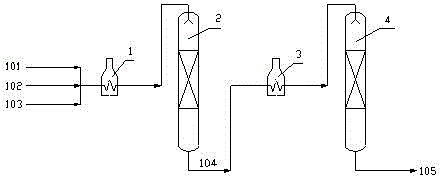The preparation method of isobutene
A technology of isobutene and isobutane, applied in chemical instruments and methods, chemical recovery, hydrocarbons, etc., can solve problems such as conversion rate, low selectivity, difficulty in large-scale process, easy deactivation of catalyst, etc., and achieve the goal of reaction process Easy, avoid frequent regeneration, easy to enlarge the effect
- Summary
- Abstract
- Description
- Claims
- Application Information
AI Technical Summary
Problems solved by technology
Method used
Image
Examples
Embodiment 1
[0026] A 100,000 tons / year isobutane dehydrogenation to isobutene plant (annual operating hours 8,000 hours), the isobutane dehydrogenation to isobutene reaction part uses figure 1 technology. An alumina catalyst containing 0.77% Pt by weight of the catalyst is used. The raw material isobutane, circulating hydrogen and water vapor are mixed and passed into the adiabatic fixed bed dehydrogenation reactor. The molar ratio of isobutane to hydrogen is 2.5, the molar ratio of water vapor to isobutane is 4, and the inlet temperature of the first reactor is 618 ℃, the inlet temperature of the second reactor is 628℃, the outlet temperature of the first reaction is 520℃, the outlet temperature of the second reactor is 563℃, the reaction pressure is 0.1MPa, and the weight space velocity of isobutane is 4.0 hours -1 Under certain conditions, isobutene is produced in two-stage fixed-bed reactors with interstage heat exchange. A heating furnace is arranged between the reactors to heat th...
Embodiment 2
[0029] A 100,000 tons / year isobutane dehydrogenation to isobutene plant (annual operating hours 8,000 hours), the isobutane dehydrogenation to isobutene reaction part uses figure 1 technology. The molar ratio of isobutane to hydrogen is 2.5, the molar ratio of water vapor to isobutane is 1.2, the inlet temperature of the first reactor is 645°C, the inlet temperature of the second reactor is 650°C, the outlet temperature of the first reaction is 520°C, and the temperature of the second reactor is 520°C. Reactor outlet temperature 563 ℃, other conditions are the same as embodiment 1.
[0030] The single reaction conversion rate is 50%, the isobutene selectivity is 89%, the reaction regeneration cycle is 84 hours, and the regeneration time is 8 hours.
Embodiment 3
[0032] A 100,000 tons / year isobutane dehydrogenation to isobutene plant (annual operating hours 8,000 hours), the isobutane dehydrogenation to isobutene reaction part uses figure 1 technology. The molar ratio of isobutane to hydrogen is 2.5, the molar ratio of water vapor to isobutane is 5, the inlet temperature of the first reactor is 613°C, the inlet temperature of the second reactor is 623°C, the outlet temperature of the first reaction is 520°C, and the temperature of the second reactor is 520°C. Reactor outlet temperature 562 ℃, other conditions are the same as embodiment 1.
[0033] The single reaction conversion rate is 56%, the isobutene selectivity is 92%, the reaction regeneration cycle is 120 hours, and the regeneration time is 8 hours.
PUM
 Login to View More
Login to View More Abstract
Description
Claims
Application Information
 Login to View More
Login to View More - R&D
- Intellectual Property
- Life Sciences
- Materials
- Tech Scout
- Unparalleled Data Quality
- Higher Quality Content
- 60% Fewer Hallucinations
Browse by: Latest US Patents, China's latest patents, Technical Efficacy Thesaurus, Application Domain, Technology Topic, Popular Technical Reports.
© 2025 PatSnap. All rights reserved.Legal|Privacy policy|Modern Slavery Act Transparency Statement|Sitemap|About US| Contact US: help@patsnap.com

